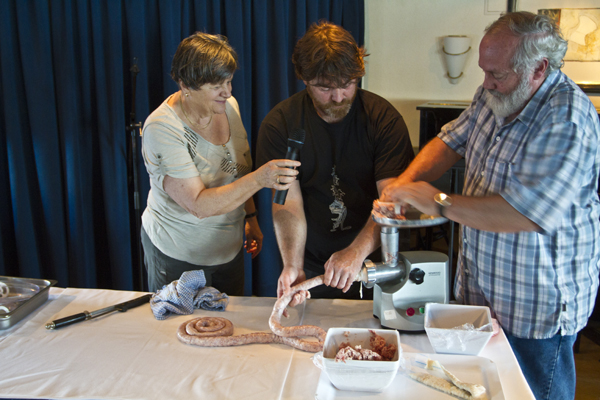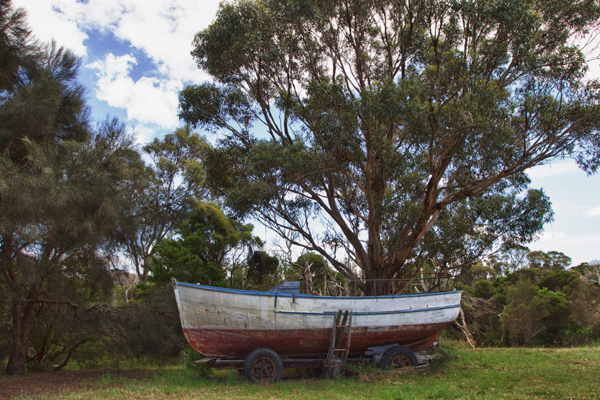
Ross O'Meara, center, making sausages from his own pigs. Photo by David Lansing.
Last night at dinner I was talking about my desire to find some good wallaby salami with Ross O’Meara, a pig farmer from South Bruny Island. Actually, Ross is a lot more than just a pig farmer. A former chef (he’s worked in several Michelin-starred restaurants in London and Asia as well as Australia), he’s also involved in a food show on Australian television and is partners with a couple of cheese makers in a shop in Hobart called Rare Food.
I really dig Ross (as well as his lovely wife, Emma, and their red-headed toddler, Felix). Ask him what he’s doing on his farm and he gets all animated and excited as he talks about his Wessex-Saddleback porkers and his heirloom chickens, and the lovely Bruny Island cheese made by his business partner, Nick Haddow. Ross is also a hunter and likes to take the occasional wallaby. “God, it’s lovely,” he tells me, his hands flying and his eyes sparkling.

Felix and Emma O'Meara. Photo by David Lansing.
This is all a bit ironic since Emma, who looks a bit like a happier version of the Mona Lisa, is a vegetarian. Imagine being vegetarian and being married to someone who makes a living turning pigs into sausage and the like. I asked Ross at dinner last night how long he’d been dating Emma before he found out she was vegetarian. “Must have been at least a month,” he said. “It just never came up. And it didn’t matter. Neither one of us has ever tried to convert the other.”
As I said, a lovely couple.
Anyway, Ross brought 20 kilos of pork shoulder from one of his rare breed pigs (in addition to the Wessex-Saddleback, he also raises Aubrey and Berkshire hogs) on board the Orion at Launceston and this morning Ross and the ship’s executive chef, Frederic Cyr, a lovely bald-headed French-Canadian, ground the pork, and then this afternoon we all sat around in the comfy Leda Lounge, where the lectures are held, and watched as Ross made sausages from scratch.
“When you make sausage, you want it to be 15-20% fat,” Ross said, adding that as far as he was concerned “if it runs a little higher in fat content there’s no harm done.” He insists on using natural casings (ox, pig, and sheep, depending on the size of the sausage) and doesn’t use any preservatives—just pure sea salt, pepper, and a little nutmeg and allspice.
Before Ross ran the ground pork through the Cuisinart sausage maker, he passed around a little plate of the meat so we could taste it if we wanted. A hand shot up—“It’s okay to eat raw pork?” I eat it all the time, he said, and I’m still here. When the plate got to me, I had a taste; it was sweet and flavorful.
The pork was fed into the sausage maker and Ross slowly fed it into the casings, squeezing the skins to keep out the air, and in just a few minutes he had one long inch-thick sausage that was probably four feet long. Then he tied one end and did some fancy little twisting and turning, like those guys that make giraffes out of balloons, and soon he had a couple dozen fat pork links (he and Frederic had made most of the sausages this morning). Unfortunately, we don’t get to sample them tonight; he likes to let them rest for 12 hours. So the plan is to have them for lunch tomorrow. Can’t wait. In the meantime, Ross has promised to get me some wallaby meat when our ship docks in Hobart. That should be interesting.







Recent Comments